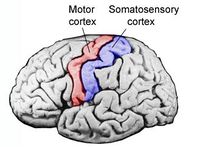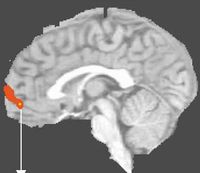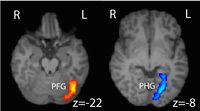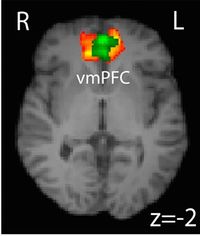מאמר: A mechanistic account of value computation in the human brain
סיכום המאמר A mechanistic account of value computation in the human brain[1]
תוכן עניינים |
מאמר
מבוא
בחיי היום יום שלנו אנו כנראה מבצעים הערכות מסתברות על הקשר בין הערכים שאנו צופים בהם, לבין התוצאות שאנו צופים שיקרו. למרות ההתקדמות בהתפתחות ההבנה ביחס שבין תגמול והחלטות-תלויות-ערך[2] [3] [4] [5] [6] [7] [8] [9] אך עדיין לא ברור איך המוח משווה בין מקורות שונים של מידע הסתברותי, ואיך הם מחושבים כדי להעריך את התוצאה המצופה. מחקר בקבלת החלטות ממידע חזותי ביסס את את האזורים מבוססי קטגוריה, המשמשים לקבלת החלטות[10] [11] [12] [13] [14] [15].
עד היום לא ברור האם האזורים הללו גם מכילים את המידע ההסתברותי (ההשערה ההסברותית). חוסר המידע לגבי ההסתברות, הקשה על בניית מודל להסברת תהליך קבלת ההחלטות. למרות שיש מחקרים שמראים שבתהליך ההסתברות מעורב ה- medial prefrontal cortex [16] [17] [18] [19] [20] [21] [22] [23] [24] [25]. עדיין לא ידוע האם הוא מעורב בחישוב ההסתברות, או שהוא רק משקף את התוצאה.
למעשה המידע המכנסיטי היחידי הידוע כיום הוא על קבלת החלטות חזותית. המחקרים מראים כי מידע בינרי מחושב על פי הפלט של האינטגרציה של ההבדלים בין אוכלוסיות הניורונים המחוברות למידע חזותי.(13 - 18, 28). עדים לא ידוע האם מכניזם זה קשור להחלטות מבוססות-ערך. כדי לבחון האם אינטגרציה כזאת קיימת גם בהחלטות מבוססות ערך בנינו שתי היפוטזות. בראשונה הנחנו כי אזורי מוח שונים מיצגים מידע-חושי שונה במהלך קבלת ההחלטות. ההנחה השניה אמרה כי בדומה לקבלת החלטות ויזואלית, סיגנלים מאזורים אלו משולבים כדי להשוות את פלטי האוכלוסיות לצורך השוואה שנועדה לקבלת החלטות.
תוצאות
5 בתים שונים ו- 5 פרצופים שונים קיבלו ערך תגמול (בתים שלילי ופרצופים חיובי, כשיש שונות בין הפרטים). הם משתמשים בתהליך ביאסיני כדי לחשב הסתברות. לאחר לימוד, העריכו את הנבדקים על פי רמת הדיוק שלהם.
המטרה הראשונה שלנו היתה לבחון האם תהליכים הסתברותיים מתבצעים ב- ventral temporal cortex (האונה הטמפורלית (הצידית, הקידמית)). לכן הערכנו שהאונה הטמפורלית הקידמית תגיב בצורה חיובית ללוג-ביאסייני של הגירוי. מצאנו כי האזורים PFG היא קורלטיבי להסתברות והאזור PHG היא בקורלוציה שלילית להסתברות. שימו לב כי אזורים אלו קרובים אך מובדלים מהאזורים המזהים בתים parahippocampal place area (PPA) ופרצופים fusiform face area (FFA). גילינו כי אכן יש תאימות בין אזורים אלו לההסתברות של תגמול על פי בתים/פרצופים. ביססנו את ההנחה כי האזורים בקורטקס החושי (sensory cortex) אכן פועלים לזיהוי הסתברות.
אני קצת קופץ לתוצאות בגלל מחסור זמן.
המחקר מבסס את ההנחה כי ה- vmPFC - ventromedial prefrontal cortex משווה אינפוטים שמגיעים משני האזורים ולפי זה מנבא את התוצאה.
תובנות
מידע חושי משווה ב- vmPFC. אני מעריך כי סה"כ המידע החיובי או השלילי מעובר לאזור זה, והוא בוחר בין שתי האפשרויות. לכן קל לנו לבחור בין שתי אפשרויות. סך כל המעגלים והחיבורים הערכיים והרגשיים (אמיגדלה) מייצרים את ההבדל בין שתי האפשרויות. סביר שכאשר מקבלים החלטה מהזכרון, היא מעלה מה-working memeory את שתי האפשרויות, והן מייצרות זרימה ברשתות המדמות את שתי האופציות.
לא ברור, האם ניתן לעשות השוואה בין שלוש או יותר אפשרויות. בכל מקרה, ההחלטה היא אינטואיטיבית (אלא אם משתמשים בלוגיקה/מחברת/וכיוב'), ונובעת מסך כל ההקשרים הקשורים לאופציות השונות.
לכן כאשר אנו מחליטים לוגית, אנו מנסים לסטוט מהמערכת הטבעית המכילה המון מידע. באקלי, עלינו לייצג את הרשתות הללו, בצורה לאה, ולתת לאבליואציה לבצע את ההערכה בין האפשרויות השונות. עלינו לייצג את כל האפשרויות, הן מהמימד הערכי שלהם והן מהמימד הרגשי.
מידע זה מחזק את המודל של אקלי. אקלי היא למעשה רשת, שצריכה בסוף להציג תוצאה ברורה של של סך כל הצפיים והשיקולים.
מאמרים קשורים
- Value, pleasure and choice in the ventral prefrontal cortex (2011), Fabian Grabenhorst and Edmund T. Rolls, Trends in Cognitive Sciences
- Causal Role of Dorsolateral Prefrontal Cortex in Human Perceptual Decision Making,(2011) Blankenburg5 et al.Current Biology 21, 980–983
יחוסים
- ↑ A mechanistic account of value computation in the human brain.Marios G Philiastides, Guido Biele, Hauke R Heekeren (2010) PNAS, 107 (20) p. 9430-5
- ↑ Schultz W (2006) Behavioral theories and the neurophysiology of reward. Annu Rev Psychol 57:87–115.
- ↑ Montague PR, King-Casas B, Cohen JD (2006) Imaging valuation models in human choice. Annu Rev Neurosci 29:417–448.
- ↑ Rangel A, Camerer C, Montague PR (2008) A framework for studying the neurobiology of value-based decision making. Nat Rev Neurosci 9:545–556.
- ↑ Hare TA, Camerer CF, Rangel A (2009) Self-control in decision-making involves modulation of the vmPFC valuation system. Science 324:646–648.
- ↑ Kable JW, Glimcher PW (2009) The neurobiology of decision: Consensus and controversy. Neuron 63:733–745.
- ↑ Platt ML, Glimcher PW (1999) Neural correlates of decision variables in parietal cortex. Nature 400:233–238.
- ↑ Sugrue LP, Corrado GS, Newsome WT (2004) Matching behavior and the representation of value in the parietal cortex. Science 304:1782–1787.
- ↑ Kim S, Hwang J, Lee D (2008) Prefrontal coding of temporally discounted values during intertemporal choice. Neuron 59:161–172
- ↑ Gold JI, Shadlen MN (2007) The neural basis of decision making. Annu Rev Neurosci 30:535–574.
- ↑ Heekeren HR, Marrett S, Bandettini PA, Ungerleider LG (2004) A general mechanism for perceptual decision-making in the human brain. Nature 431:859–862.
- ↑ Heekeren HR, Marrett S, Ruff DA, Bandettini PA, Ungerleider LG (2006) Involvement of human left dorsolateral prefrontal cortex in perceptual decision making is independent of response modality. Proc Natl Acad Sci USA 103:10023–10028.
- ↑ Heekeren HR, Marrett S, Ungerleider LG (2008) The neural systems that mediate human perceptual decision making. Nat Rev Neurosci 9:467–479.
- ↑ Kim JN, Shadlen MN (1999) Neural correlates of a decision in the dorsolateral prefrontal cortex of the macaque. Nat Neurosci 2:176–185.
- ↑ Shadlen MN, Newsome WT (2001) Neural basis of a perceptual decision in the parietal cortex (area LIP) of the rhesus monkey. J Neurophysiol 86:1916–1936.
- ↑ Gläscher J, Hampton AN, O’Doherty JP (2009) Determining a role for ventromedial prefrontal cortex in encoding action-based value signals during reward-related decision making. Cereb Cortex 19:483–495.
- ↑ Hampton AN, O’doherty JP (2007) Decoding the neural substrates of reward-related decision making with functional MRI. Proc Natl Acad Sci USA 104:1377–1382.
- ↑ Hampton AN, Bossaerts P, O’Doherty JP (2006) The role of the ventromedial prefrontal cortex in abstract state-based inference during decision making in humans. J Neurosci 26:8360–8367.
- ↑ Daw ND, O’Doherty JP, Dayan P, Seymour B, Dolan RJ (2006) Cortical substrates for exploratory decisions in humans. Nature 441:876–879.
- ↑ Knutson B, Taylor J, Kaufman M, Peterson R, Glover G (2005) Distributed neural representation of expected value. J Neurosci 25:4806–4812.
- ↑ Blair K, et al. (2006) Choosing the lesser of two evils, the better of two goods: Specifying the roles of ventromedial prefrontal cortex and dorsal anterior cingulate in object choice. J Neurosci 26:11379–11386.
- ↑ Kable JW, Glimcher PW (2007) The neural correlates of subjective value during intertemporal choice. Nat Neurosci 10:1625–1633.
- ↑ Fellows LK, Farah MJ (2007) The role of ventromedial prefrontal cortex in decision making: judgment under uncertainty or judgment per se? Cereb Cortex 17: 2669–2674.
- ↑ Chib VS, Rangel A, Shimojo S, O’Doherty JP (2009) Evidence for a common representation of decision values for dissimilar goods in human ventromedial prefrontal cortex. J Neurosci 29:12315–12320.
- ↑ FitzGerald TH, Seymour B, Dolan RJ (2009) The role of human orbitofrontal cortex in value comparison for incommensurable objects. J Neurosci 29:8388–8395.



